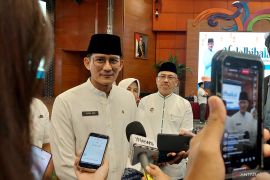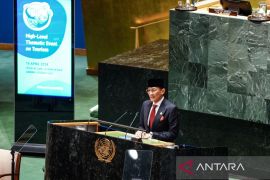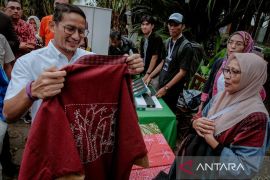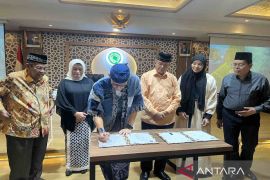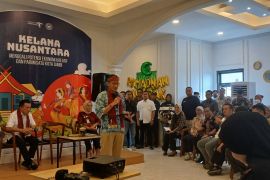Deputy Head of the Creative Economy Agency (Bekraf) Ricky J. Pesik stated at the opening of the World Conference on Creative Economy (WCCE) in Bali last week (Nov 6) that most of the creative economy players in Indonesia are small and medium enterprises (SMEs).
"They, creative economic players, rely on Bekraf to find solutions to the challenges that threaten their business, and I believe international cooperation is the key and the solution to their problem," Pesik noted in Nusa Dua, Bali.
Hence, Indonesia hosted the WCCE, the first world-level conference to discuss the creative economy.
Natural resources are dwindling, and countries around the world are moving from commodity-dependent economies to economies that rely on ideas or creative economy. After all, the creative economy has contributed significantly to economic development.
Based on Bekraf`s data, in 2016, creative economy`s contribution in the United States reached 11.1 percent; South Korea, 8.67 percent; Indonesia, 7.4 percent; Russia, six percent; Singapore, 5.7 percent; the Philippines, 4.9 percent; and Canada, 4.5 percent.
In Indonesia, as in other parts of the world, the creative economy is increasingly important.
"Just last year, the creative economy contributed almost Rp1,000 trillion to Indonesia`s gross domestic product (GDP) and became a source of employment for 16.4 million Indonesians," the Bekraf deputy head stated.
At the world level, global trade in creative industries has shown sustainable growth, even in times of the economic crisis. During the 2008 global economic and financial crises, when other sectors contracted, creative economic products recorded a positive growth.
In the meantime, the Indonesian government is also facilitating the development of startup firms in the creative economic sector. Minister of Industry Airlangga Hartarto confirmed that his ministry is actively developing startup entrepreneurs in the creative industry sector.
The effort is in line with the readiness to seize opportunities and capitalize on the momentum of the demographic bonus that Indonesia will enjoy in 2030 later.
"The domestic creative industry is able to make a significant contribution to the economy. Hence, we continue to increase our competitiveness in the domestic and global arena and also ready to enter the digital economy era," Hartarto noted in a statement in Jakarta on Monday.
The contribution of Indonesia`s creative industry to the GDP in the last three years continues to increase.
In 2015, the sector had contributed Rp852 trillion to the GDP, while in 2016, the figure had reached Rp923 trillion and increased to Rp990 trillion in 2017. The figure is projected to reach up to Rp1,000 trillion in 2018.
Hence, the country`s creative economy continued to be developed to strengthen the small-and medium-scale enterprise (SME) industry as a whole.
After all, SME is the largest segment of the national industry and is the backbone of the national economy.
"The small- and medium-scale industry remained consistent as a pillar of the Indonesian economy and has also become one of the industrial sectors able to survive in the face of the global monetary crisis," Gati Wibawaningsih, director general of SME of the Ministry of Industry, noted in Jakarta on Monday (Nov 12).
The strength of the domestic SME industry is reflected in the number of small- and medium-scale businesses that continue to increase. Based on the Ministry of Industry`s records, the number of SMEs in 2014 had reached 3.52 million and up to 4.49 million business units in the first semester of 2018.
The number of small industries increased to 970 thousand over the past four years.
"When it reached four million units in 2016, the workforce absorbed was more than 10 million people," Wibawaningsih stated.
She also expressed belief that the number of national IKM will increase in line with the growth of the middle class, which is estimated to reach 70 percent of the total population of Indonesia in 2025 later.
In order to accelerate the development of SME in the country, the government has implemented several programs. For instance, the Ministry of Industry has established the Bali Creative Industry Center (BCIC) in Denpasar since 2015.
Director General Gati Wibawaningsih explained that several programs were implemented at the BCIC, including the Creative Business Incubator. This year, the ministry`s Directorate General of SME collaborates with the Business Venturing and Development Institute Prasetya Mulya.
"Through the program, creative economy players in the fields of crafts and fashion will be offered training and assistance to develop their business," Wibawaningsih remarked.
Wibawaningsih asserted that her side was aggressively producing new entrepreneurs in the small- and medium-scale business sector. Along with the development of the industrial revolution era 4.0, national SME actors were encouraged to immediately utilize the latest technology.
Data at the Central Statistics Agency indicates that production growth of the micro and small manufacturing industries in the third quarter of 2018 rose by 3.88 percent year-on-year as compared to that recorded in the third quarter of 2017.
(T.A014/A/KR-BSR/A014) 13-11-2018 22:57:01
Reporter: Andi Abdussalam
Editor: Andi Abdussalam
Copyright © ANTARA 2018

